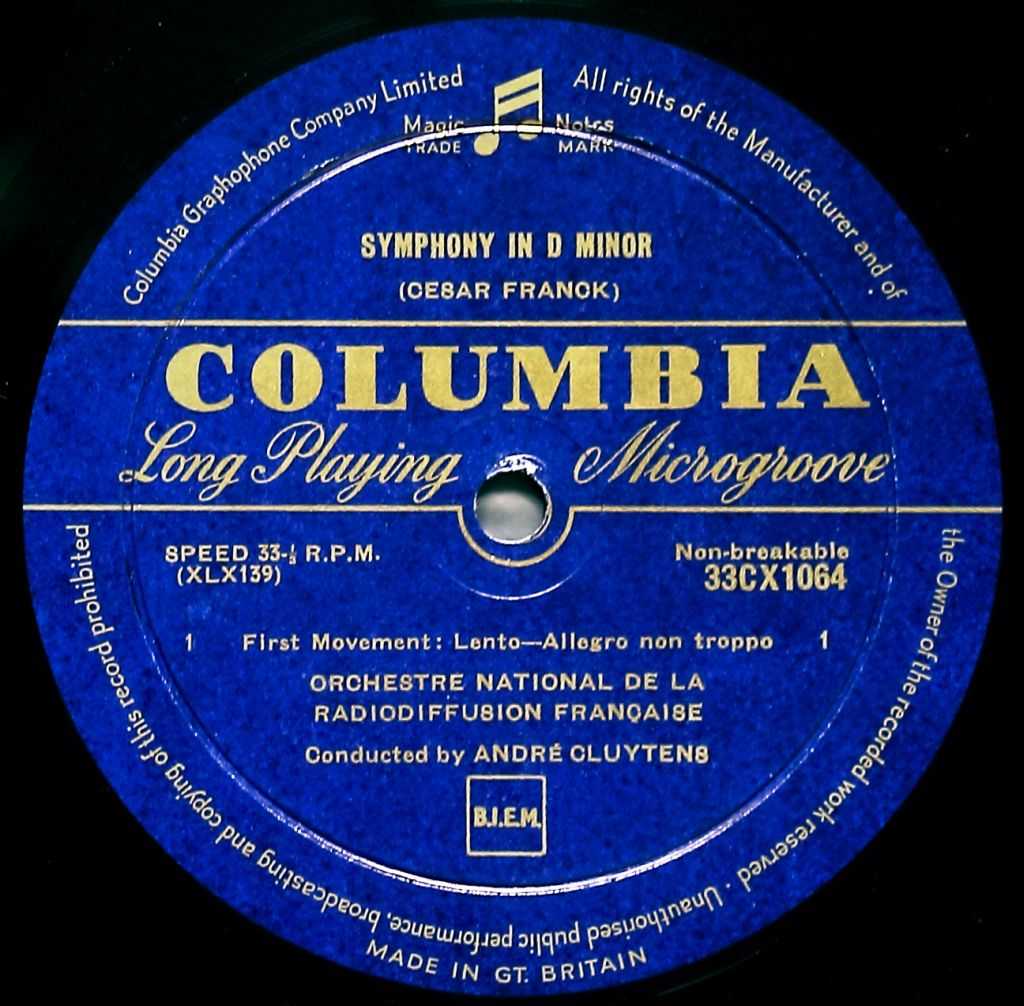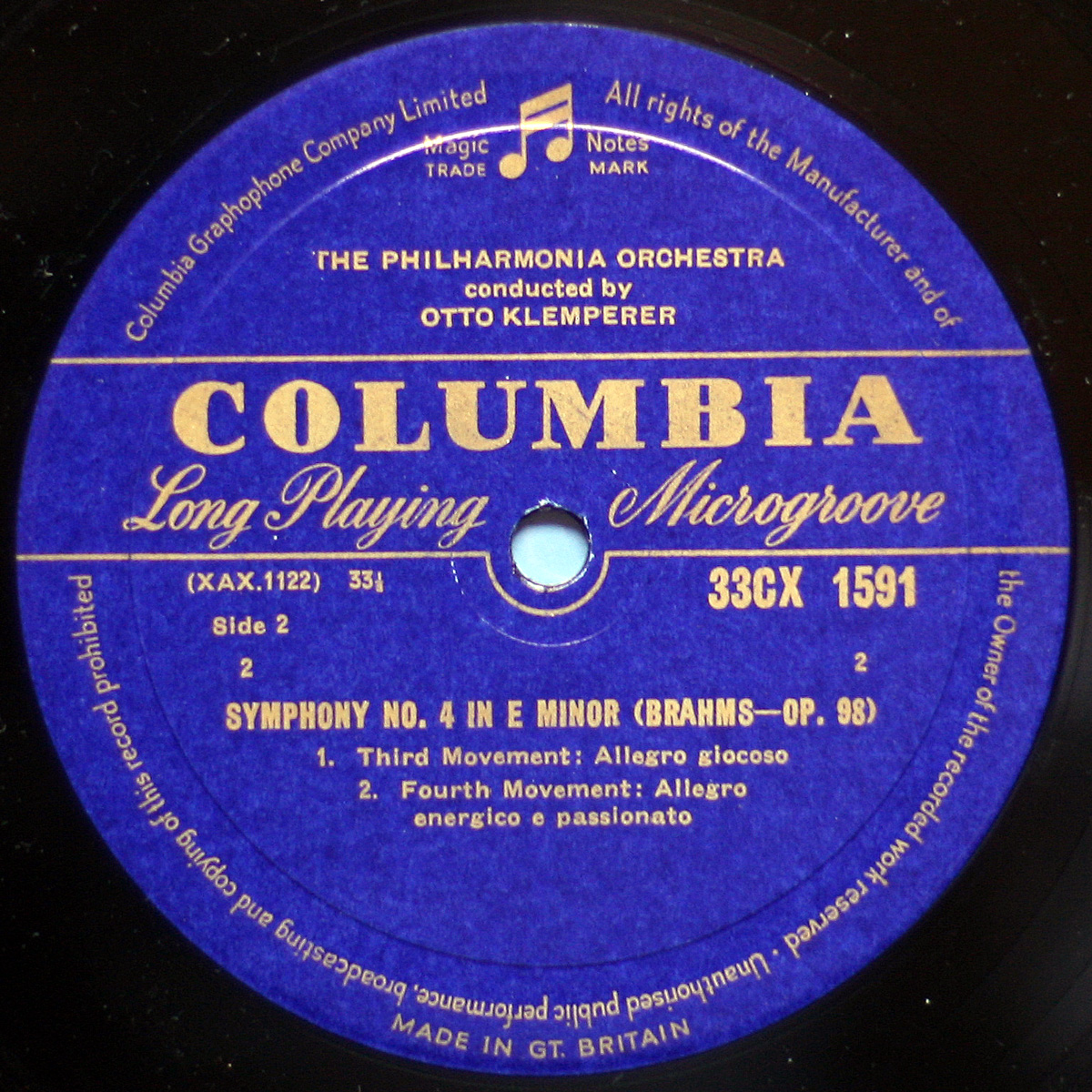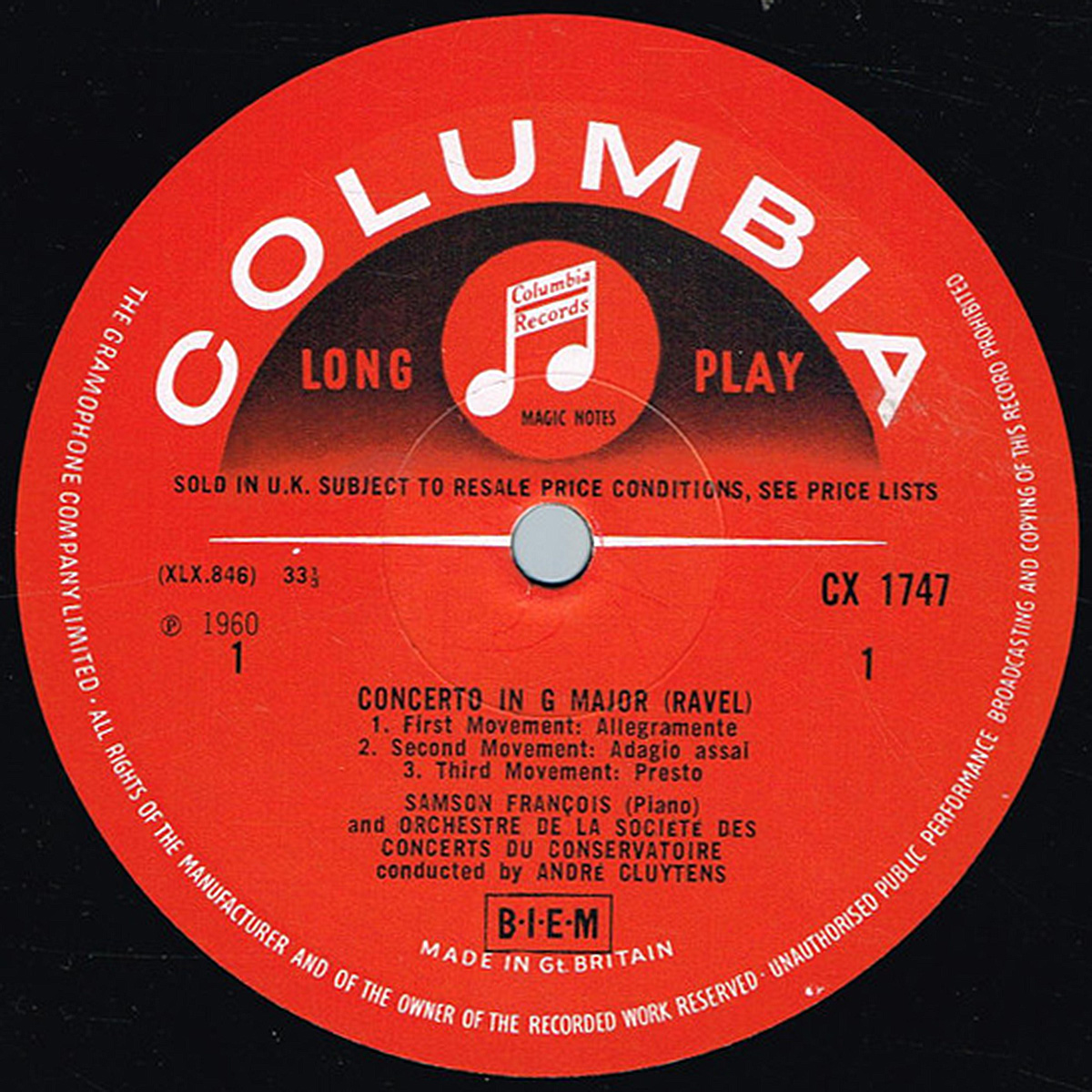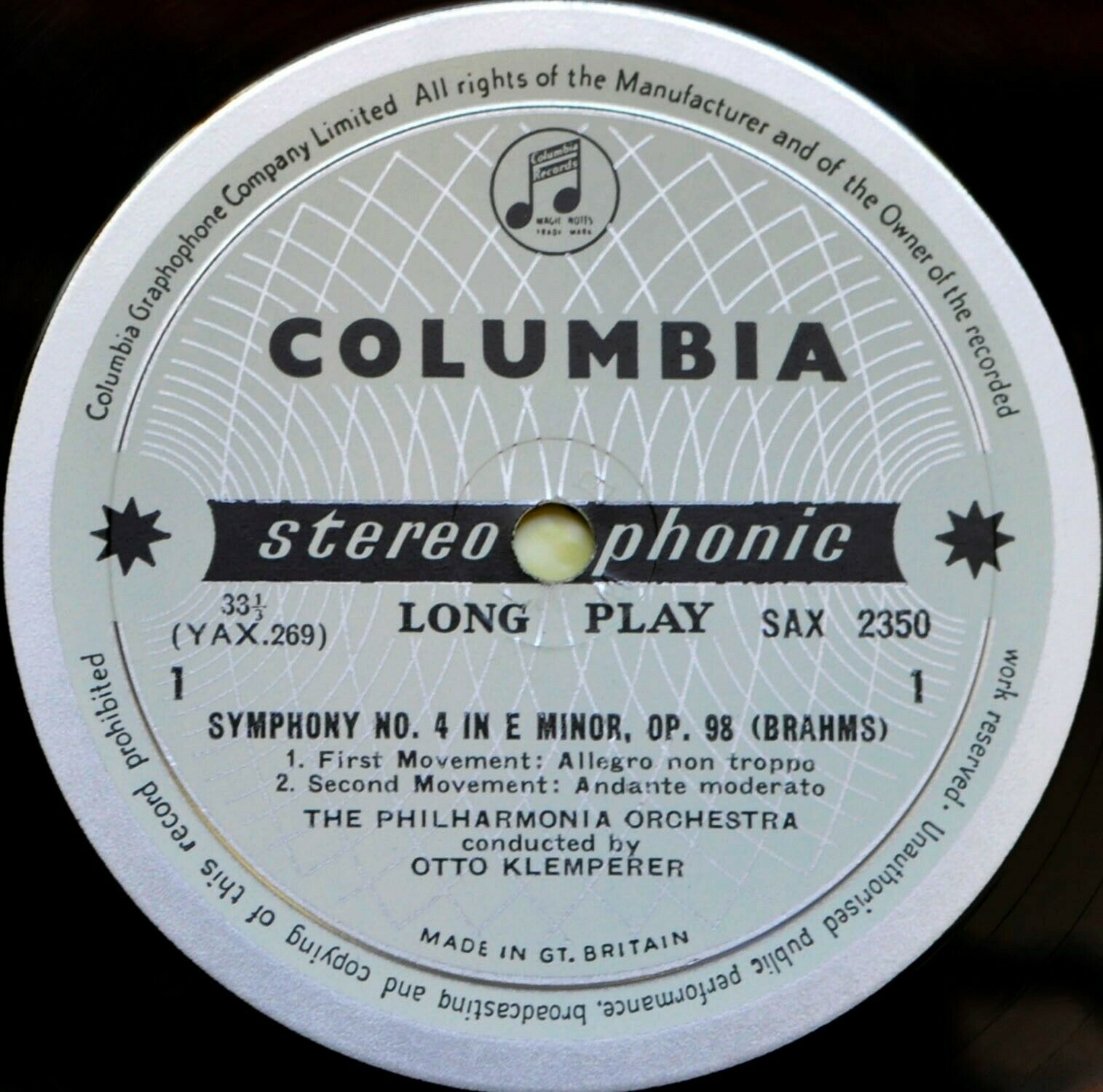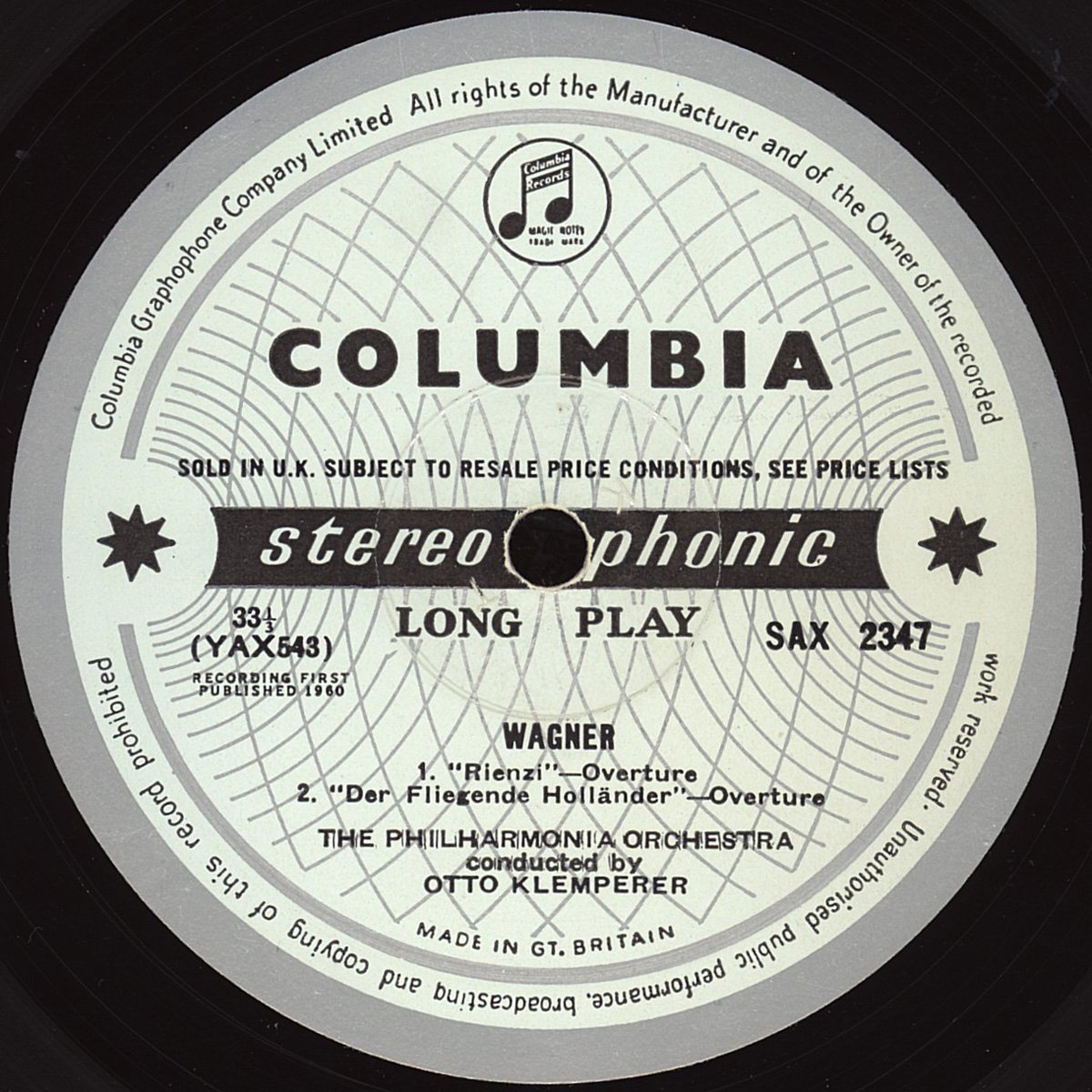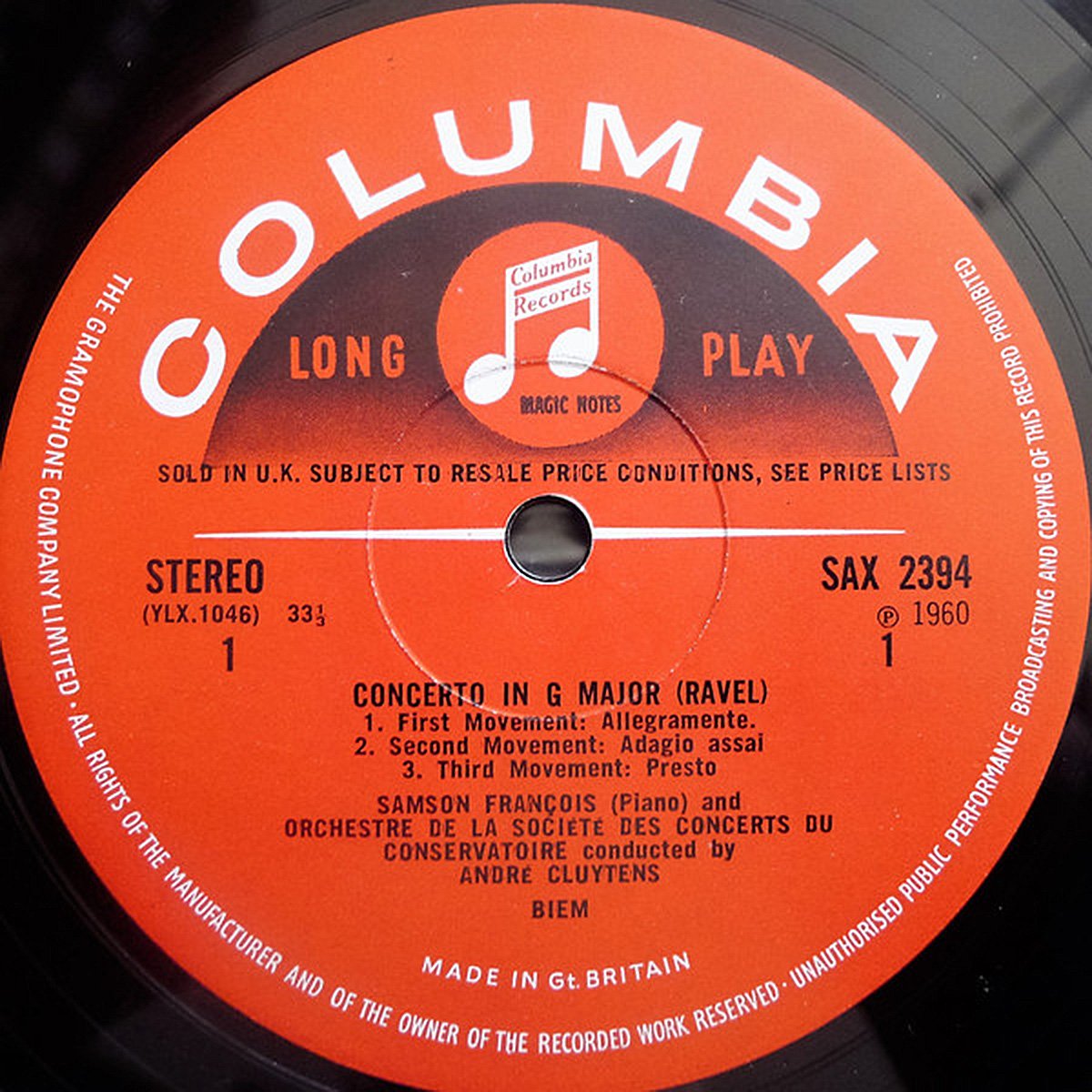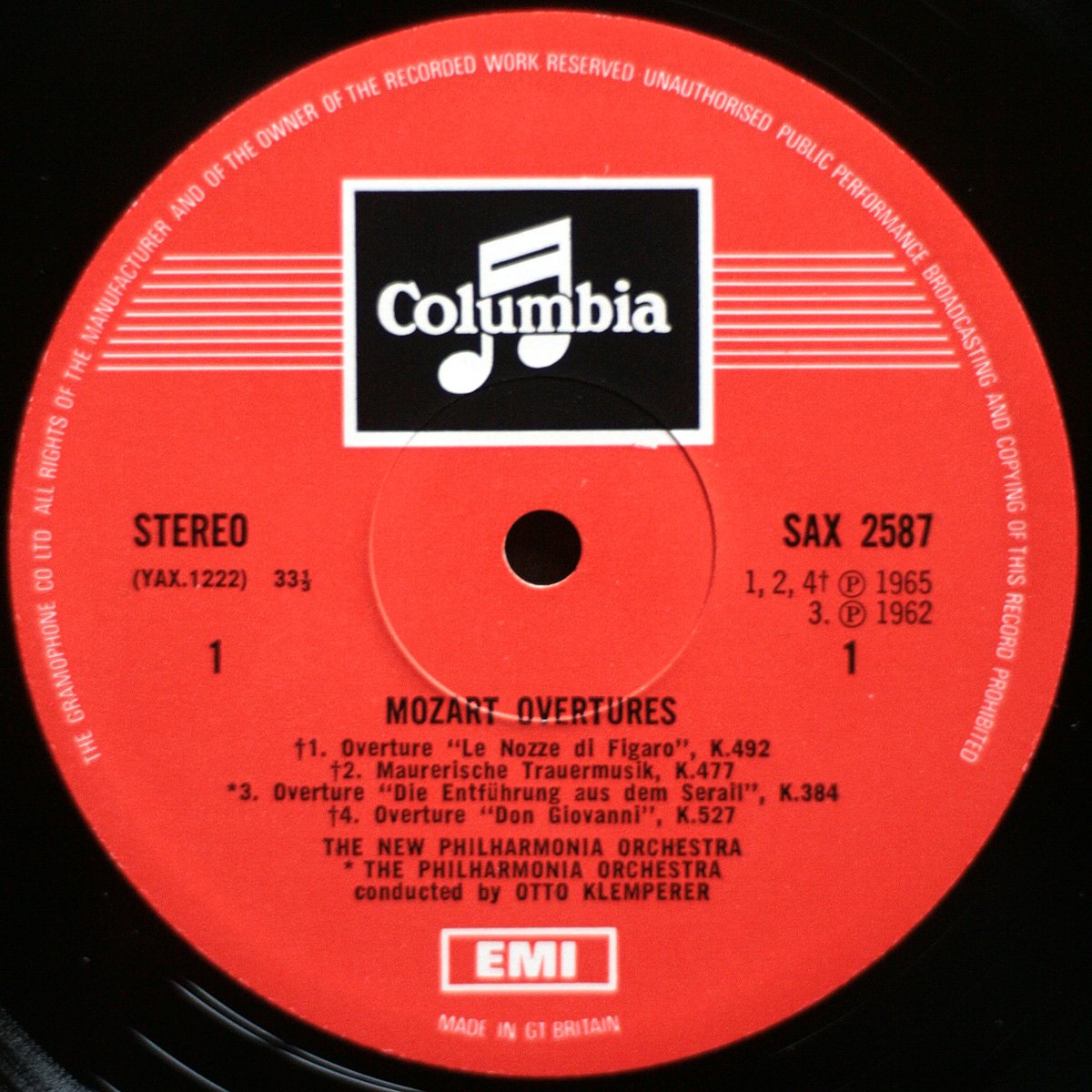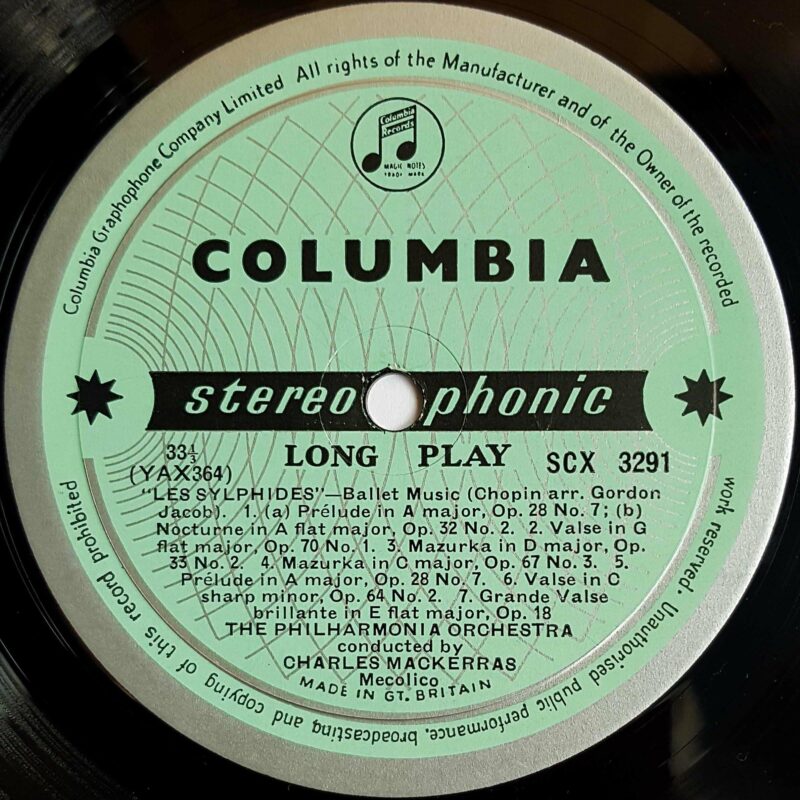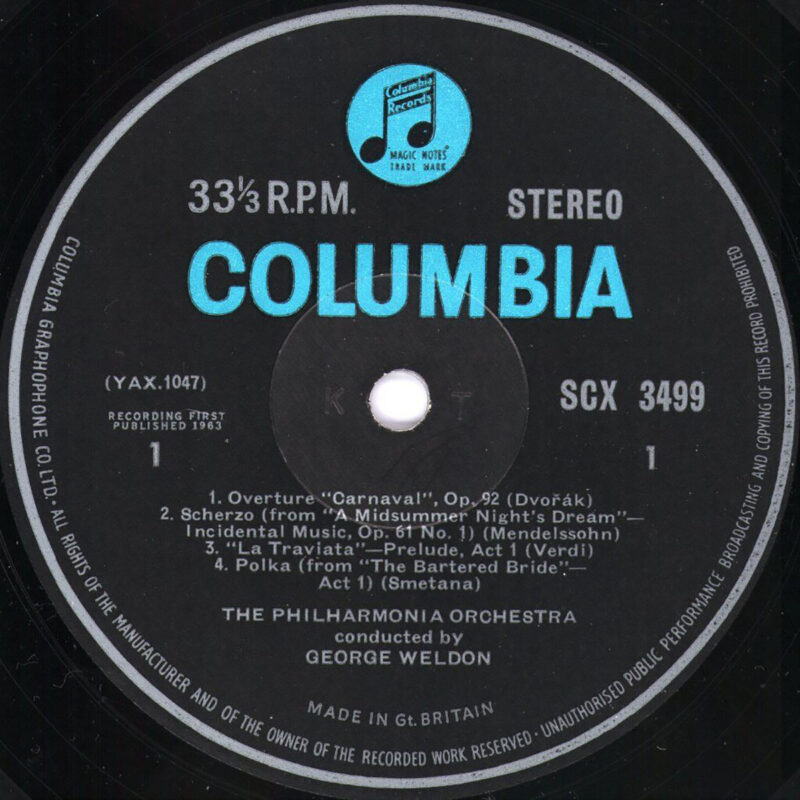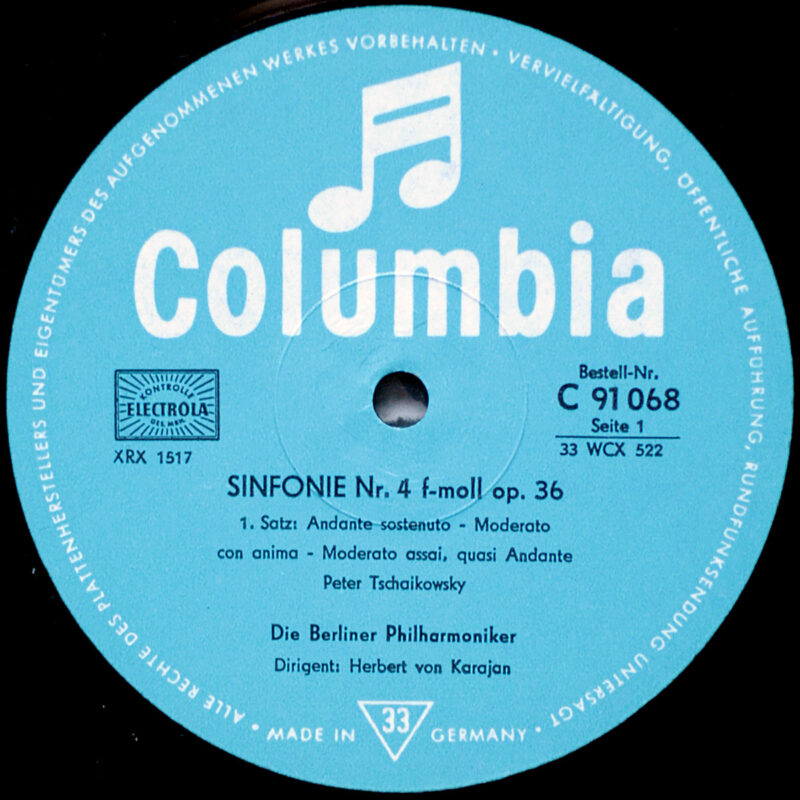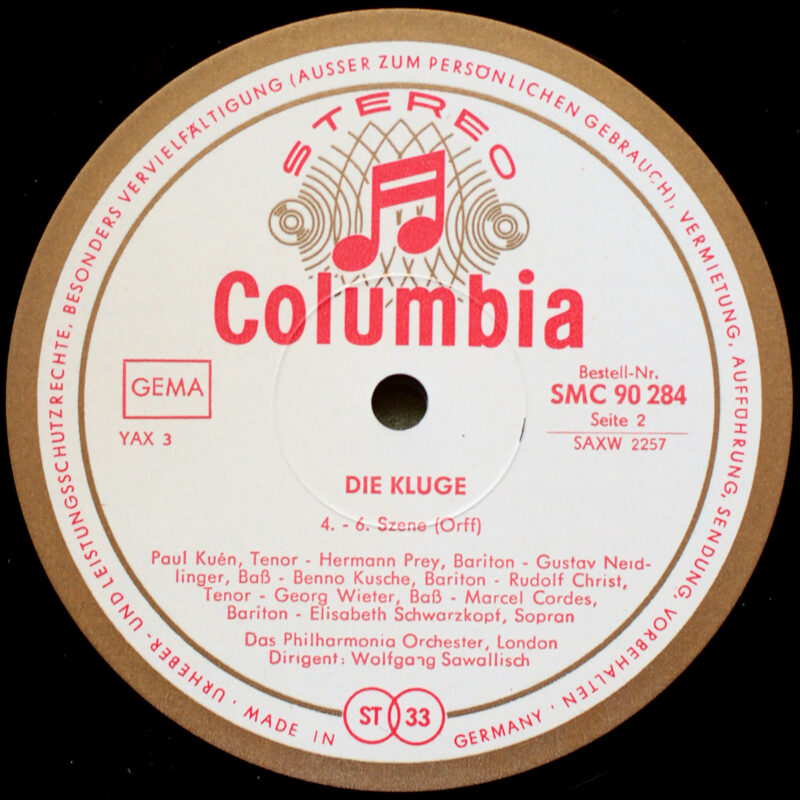Guide photographique des étiquettes
des disques Columbia England
Nomenclature des disques Columbia
Série 33CX – Mono – « Blue & Gold »
La série Columbia 33CX a été lancée en 1952 et a été produite jusqu’en 1963, après quoi, toutes les nouvelles versions étaient uniquement stéréo. Elle comporte deux séries : 33CX 1000 et 33CX 5000. La série 33CX 1000, qui est la plus ancienne, va du 33CX 1001 au 33CX 1949, et la série 33CX 5000 va du 33CX 5251 au 33CX 5294. Tous les disques de la série CX ont un pressage anglais. La série 33CX a été utilisée pour tous les disques mono.
L’étiquette est de couleur bleue avec les lettres dorées pour tous les logos et textes. Elle a aussi le texte « Long Playing Microgroove » écrit dans la partie supérieure centrale de l’étiquette, juste sous le mot « Columbia ». Elle est appelée « Blue & Gold » ou « English Blue 1st ».
Les toutes premières éditions du 33CX ont un pressage lourd et épais, ce pressage est assez rare. L’étiquette porte la mention « Non breakable » au-dessus du code du disque et il y a une profonde rainure à environ 1cm du bord de l’étiquette.
De nombreux 33CX émis à partir de 1958 ont également été réédités en stéréo, mais il y a eu de nombreux 33CX uniquement en mono. Le dernier 33CX uniquement mono serait le 33CX 1888 (?).
La plupart des pressages 33CX comportent une protection du sillon. Le bord du disque présente une zone légèrement surélevée. Ce bord était destiné à protéger le disque lorsqu’une platine à chargement automatique était utilisée. Les changeurs automatiques avaient une longue broche, et plusieurs disques pouvaient être chargés sur la broche, et lorsqu’un disque finissait de jouer, le disque suivant tombait. C’était évidemment très utile pour les 78 tours, lorsqu’une symphonie nécessitait 10 ou 12 disques.
Les changeurs automatiques ont continué à être utilisés dans les années 1950 et même 1960. Parfois, on trouve un coffret d’opéra doté d’un « couplage automatique », de sorte que le premier disque comporte les faces 1 et 6, le second les faces 2 et 5, et le troisième les faces 3 et 4.
Quelques disques appartenant à la série CX sont accompagnés d’une étiquette verte indiquant qu’ils font partie de la collection « Masterworks ».
The Columbia 33CX series was first launched in 1952 and were produced until 1963, after which, all new relases were stereo only. At Columbia, mono LPs fall into two series: the 33 CX 1000 and the 33CX 5000. The 33CX 2000 serie, which is the earliest, runs from 33CX 1001 up to 33CX 1949, and the 33CX 5000 serie runs from 33CX 5251 to 33CX 5294. All records from the CX series have an English pressing. The 33CX serie was used on all mono records.
The label is blue with gold lettering for all logos and text. It also has the words “Long Playing Microgroove” written in the upper middle part of the label just under “Columbia”. This is listed as “Blue & Gold” or “English Blue 1st”.
The very earliest 33CX issues have a heavy, flat pressing, this pressing is quite rare. The label had « Non breakable » above the record code and there is a deep groove about 1cm from the edge of the label.
Many of the 33CXs issued from 1958 onwards were also re-issued in stereo, but there were still many mono-only 33CXs issued. The last mono-only 33CX would be the 33CX 1888.
Most 33CX pressings are groove guard pressings. The rim has a slightly raised area. This was to protect the record when an auto-changer turntable was used. Auto-changers had a long spindle, and several records could be loaded onto the spindle, and when one finished playing the next record would drop on top of it. This was clearly very useful for 78rpm records, when a symphony would need 10 or 12 records.
Auto-changers continued to be used into the 1950s and even the 1960s. Sometimes we find an opera set that has « automatic coupling » so that the first record has sides 1 & 6, the second has sides 2 & 5, and the third has sides 3 & 4.
A few records belonging to the CX series come with a green label signifying that they are part of the ‘Masterworks’ collection.
Série 33CX – Mono – « Red Semi Circle »
La deuxième étiquette mono est de couleur rouge avec un lettrage noir et un demi-cercle noir. Il comporte également un logo « Magic Notes » avec les mots « Long » et « Play » sur ses côtés gauche et droit et le mot « Columbia » écrit en demi-cercle en blanc dans la moitié supérieure de l’étiquette. Elle est appelée « Red Semi Circle » ou « English Red 1st ». Elle est utilisée pour les rééditions 33CX 1xxx et pour la série 33CX 5xxx.
The second mono label is red with black lettering and a black semicircle. It also has the « Magic Notes » logo with the words « Long » and « Play » on its left and right side and the word « Columbia » written in white in a semi-circle in the upper half of the label. This is listed as « Red Semi Circle » or « English Red 1st ». It is used for the 33CX 1xxx reissues and for the 33CX 5xxx series.
Série SAX – Stéréo – « Blue & Silver »
La série stéréophonique SAX a été lancée en 1958. Elle comporte deux séries : SAX 2000 et SAX 5000. La série SAX 2000 va du SAX 2252 au SAX 2589, et la série SAX 5000 va du SAX 5268 au SAX 5294.
L’étiquette est bleu pâle avec des lignes argentées et un lettrage noir. Il y a le logo « Magic Notes » et le mot « Columbia » écrit en dessous en noir dans la moitié supérieure de l’étiquette. Le mot « Stereophonic » est sur fond noir au centre de l’étiquette. Elle est utilisée pour la série SAX 2252 à SAX 2539, à l’exception des références SAX 2526 et SAX 2532 (parues après l’utilisation de la nouvelle étiquette « Red Semi Circle »). Elle est également utilisée pour la réédition en stéréo des références 33CX. Elle est appelée « Blue Silver » ou « Tortoise » ou « English Silver 1st ».
Il existe une variante avec le texte « Sold in U.K. subject to resale price conditions, see price lists » au dessus du mot « Stereophonic ».
The SAX series of stéréophonics issues were launched in 1958. She has two series: SAX 2000 et SAX 5000. The SAX 2000 serie runs from SAX 2252 up to SAX 2589, and the SAX 5000 serie runs from SAX 5268 to SAX 5294. All of the later issues were unified to the ASD serial of EMI/HMV.
The label is pale blue with silver lines and black letterring. It also has the « Magic Notes » logo nd the word « Columbia » written in black in the upper half of the label. The word « Stereophonic » is on a black background in the center of the label. It is used for the SAX 2252 to SAX 2539 series, with the exception of SAX 2526 and SAX 2532 (released after the new « Red Semi Circle » label was used). It is used also for the stereophonic reissue of the 33CX references. This is listed as « Blue Silver » or « Tortoise » or English Silver 1st »
There is a variant with the text « Sold in U.K. subject to resale price conditions, see price lists » above the word « Stereophonic ».
Série SAX – Stéréo – « Red Semi Circle »
La série stéréophonique SAX a été lancée en 1958. Elle comporte deux séries : SAX 2000 et SAX 5000. La série SAX 2000 va du SAX 2252 au SAX 2589, et la série SAX 5000 va du SAX 5268 au SAX 5294. Toutes les parutions ultérieures ont été regroupées sous la réfrence ASD chez EMI/HMV.
L’étiquette est semblable à la mono. Elle est couleur rouge avec un lettrage noir et un demi-cercle noir. Il y a également un logo « Magic Notes » avec les mots « Long » et « Play » sur ses côtés gauche et droit et le mot « Columbia » écrit en demi-cercle en blanc dans la moitié supérieure de l’étiquette. La principale différence avec la mono est le mot « Stéréo » situé à gauche de l’étiquette. Elle est utilisée pour les références SAX 2526 (paru en 1964), SAX 2532 et les références SAX 2540 et suivantes, ainsi que les SAX 5268 à 5294 (parues en 1964). Elle est également utilisée pour la réédition en stéréo des références 33CX. Elle est appelée « Red Semi Circle » ou « English Red 2nd ».
The SAX series of stéréophonics issues were launched in 1958. She has two series: SAX 2000 et SAX 5000. The SAX 2000 serie runs from SAX 2252 up to SAX 2589, and the SAX 5000 serie runs from SAX 5268 to SAX 5294. All of the later issues were unified to the ASD serial of EMI/HMV.
The label is the same as the mono. She is red with black lettering and a black semicircle. It also has the « Magic Notes » logo with the words « Long » and « Play » on its left and right side and the word « Columbia » written in white in a semi-circle in the upper half of the label. The main difference with mono is the word « Stereo » on the left of the label. It is used for SAX 2526 (released in 1964), SAX 2532 and SAX 2540 onwards, and SAX 5268 to 5294 (released in 1966). It is used also for the stereophonic reissue of the 33CX references. This is listed as « Red Semi Circle » or « English Red 2nd ».
Série SAX – Stéréo – « Magic Notes »
L’étiquette est de couleur rouge avec un lettrage noir. Le demi-cercle noir, dans la moitié supérieure de l’étiquette, est remplacé par un rectangle noir. Le logo « Magic Notes » et le mot « Columbia » sont écrits en blanc dans ce cartouche. Elle est utilisée uniquement utilisée pour la réédition en stéréo des références 33CX. Elle est appelée « Magic Notes » ou « English Red 3rd ».
The label is red with black lettering. The black semi-circle in the upper half of the label is replaced by a black rectangle. The « Magic Notes » logo and the word « Columbia » are written in white in this cartouche. It is used only for the stereo reissue of the 33CX references. It is called « Magic Notes » or « English Red 3rd ».
Série SCX – Stéréo – « Magic Notes »
La série stéréophonique SCX est similaire à la série SAX au niveau du son. La plupart des parutions Columbia SCX ne sont pas de la musique classique, mais la série comporte quelques disques remarquables. Les chefs d’orchestre les plus connus sur ce label sont André Cluytens, Henry Krips, Charles Mackerras, George Szell et George Weldon
La première étiquette est similaire à la série SAX mono « Blue Silver ». L’étiquette est vert pale et argent avec des lignes argentées et un lettrage noir. Il y a le logo « Magic Notes » et le mot « Columbia » écrit en dessous en noir dans la moitié supérieure de l’étiquette. Le mot « Stereophonic » est sur fond noir au centre de l’étiquette. Le premier disque SCX est le SCX 3251, Waldteufel Waltzes, dirigé par Henry Krips, publié en 1958, et le dernier avec étiquette argent/vert original est SCX 3467, Bach Organ Recital d’Edouard Commette, publié en 1962.
La seconde étiquette est noire avec un lettrage blanc. Il y a le logo « Magic Notes » et le mot « Columbia » écrit en dessous en bleu turquoise dans la moitié supérieure de l’étiquette. La première référence SCX turquoise/noire est SCX 3499, Weldon dirigeant l’ouverture 1812 de Tchaïkovski, publiée en 1963 et la dernière référence est SCX 6132, Judith Raskin – Lieder de Mahler, publiée en 1966.
The SCX stereo series is similar in sound to the SAX series. Most of the Columbia SCX releases are not classical music, but there are a few outstanding records. The most famous conductors on this label are André Cluytens, Henry Krips, Charles Mackerras, George Szell and George Weldon
The first label is pale green with silver lines and black letterring. It also has the « Magic Notes » logo nd the word « Columbia » written in black in the upper half of the label. The word « Stereophonic » is on a black background in the center of the label. The first SCX is SCX 3251, Waldteufel Waltzes, conducted by Henry Krips, issued in 1958, and the last original with silver/green label is SCX 3467, Bach Organ Recital by Edouard Commette, issued in 1962.
The second label is black with white lettering. It also has the « Magic Notes » logo nd the word « Columbia » written in turquoise blue in the upper half of the label. The first original turquoise/black label is SCX 3499, Weldon conducting Tchaikovsky’s 1812 Overture, issued in 1963 and the last original turquoise/black label is SCX 6132, Judith Raskin – Mahler Songs, issued in 1966.
Série 33CX
12” – 33 tours – Mono
33CX 1xxx
33CX 1001 au 33CX 1949
Not issued: 33CX 1041-2, 1169, 1177, 1184, 1200, 1209-10, 1214, 1234, 1312, 1314, 1336, 1360, 1423, 1441, 1452, 1454-5, 1461, 1510, 1576, 1640, 1646, 1659, 1779, 1794, 1873, 1909, 1929, 1947,
33CX 5xxx
33CX 5251 au 33CX 5294
Not issued: 33CX 5270,
Série SAX
12” – 33 tours – Stéréo
SAX 2xxx
SAX 2252 au SAX 2589
Not issued: SAX 2273, 2295, 2301, 2305, 2311-14, 2325-6, 2330, 2334, 2349, 2396, 2425, 2440, 2568, 2581, 2585-6,
SAX 5xxx
SAX 5268 au SAX 5294
Not issued: SAX 5270
Série SCX – Vert
12” – 33 tours – Stéréo
SCX 3xxx
SCX 3251 au SCX 3467
Série SCX – Noir
12” – 33 tours – Stéréo
SCX 3xxx
SCX 3499 au SCX 6132
Sources :
https://lee.classite.com/music/emi-lps/emi-columbia-uk-sax-intro.htm
Rare classical record price guide – Barry Browne
https://www.discogs.com/fr/
Collection personnelle

